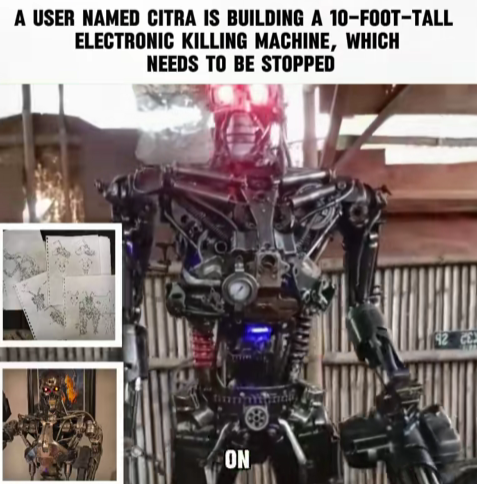The internet is buzzing after photos and videos surfaced of a user named Citra, reportedly constructing a 10-foot-tall robotic figure made of metal, sensors, and advanced circuitry. Dubbed online as an “electronic killing machine,” the creation has stirred a wave of fascination—and fear—across social media.
Citra, who describes themselves as an “independent engineer and robotics hobbyist,” began sharing progress photos of the machine months ago, showing a skeletal frame eerily similar to Hollywood’s infamous Terminator robot. In the latest images, the massive figure now features glowing red eyes, articulated joints, and even partial motion capability, leading many to question whether the project has gone too far.
“I started this as an art and engineering experiment,” Citra wrote in a now-deleted post. “I wanted to push the boundaries of what’s possible with scrap metal, sensors, and code.” But while some see it as a brilliant display of creativity, others view it as a potential danger—especially after reports suggested the machine could operate autonomously for brief periods.
Tech experts have weighed in, warning that powerful robotics built outside of regulatory oversight could pose real risks. “It’s one thing to build a small drone,” said one AI safety researcher. “It’s another to create a two-story robot capable of independent movement without strict safety protocols. Even a mechanical malfunction could cause serious harm.”
Citra’s project, nicknamed “Project Helios” by followers, reportedly incorporates parts from old industrial robots and automotive machinery. In one clip, the robot’s chest lights up as its arms shift slightly, accompanied by whirring mechanical sounds. Though Citra insists it’s far from weaponized, the imagery alone has sparked public anxiety.
Online communities have split into two camps: one applauding Citra’s ingenuity, the other calling for authorities to intervene. “We’re watching the birth of a real-life science fiction nightmare,” one user wrote. “If this thing goes rogue, who’s stopping it?” Others countered that innovation should not be punished, arguing that technological fear has always followed major breakthroughs.
Adding to the mystery, Citra has since gone silent across most platforms. Some speculate that the disappearance is due to public pressure or even intervention by government agencies. Others believe the engineer is continuing work in secret to avoid further backlash.
Whether the machine is a harmless project or a looming concern remains unclear—but its existence has reignited a global conversation about AI ethics, robotics regulation, and the responsibility of private inventors. “Technology without oversight is like fire in the wrong hands,” said one cybersecurity expert. “It can light the way—or burn everything down.”
For now, the 10-foot metallic giant stands as both a marvel of engineering and a symbol of modern-day fear—proof that the line between human innovation and potential danger is thinner than ever before.
